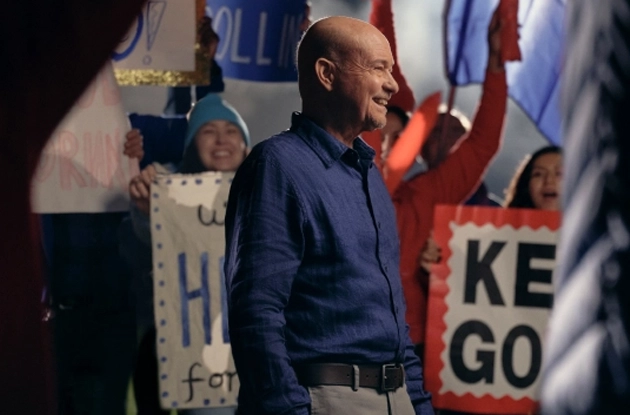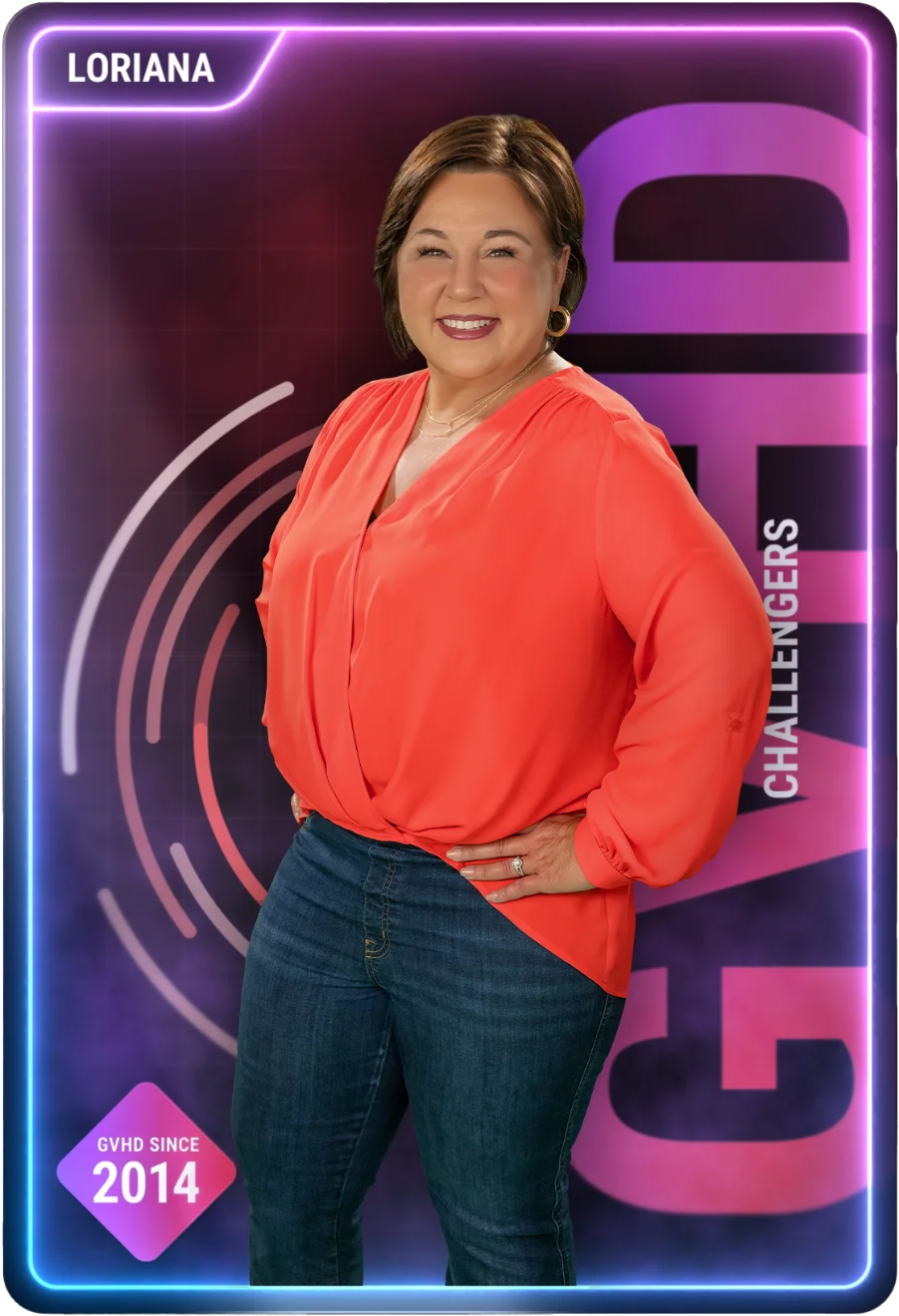Intended for US residents only
Challenge
GVHD Head-On
Graft-versus-host disease (GVHD) is a serious condition that may occur after a bone marrow transplant (BMT), potentially causing irreversible organ and tissue damage. However, early action could help prevent long-term consequences. Soccer legend Mia Hamm understands the importance of vigilance, both on and off the field. She is rallying behind her team of GVHD Challengers who are tackling the condition head-on and encouraging them to diligently monitor their symptoms.
Watch the video
MIA HAMM IS ON YOUR SIDE

Watch the video
MIA HAMM IS ON YOUR SIDE
Mia Hamm has been a passionate advocate for the BMT community since she lost her brother due to complications following a BMT more than 25 years ago. She understands that for many people, their fight doesn’t stop after the transplant. Serious complications like GVHD could follow. That’s why she is urging people to watch out for signs of GVHD and its progression.
Talk to your healthcare team as soon as you notice any new or changing GVHD symptoms.
Meet the team
THE GVHD CHALLENGERS
Tackling GVHD takes everything you’ve got—and often, just a little bit more. Symptoms may be difficult to spot but can quickly worsen and cause serious organ damage. These GVHD Challengers closely monitor their symptoms so they can stay on top of their disease.
Click on each GVHD Challenger’s card to learn about their experiences.
GVHD CHALLENGERS
Ananya’s Story
Medical student, former teacher, daughter, sister
As a young college graduate one month into her career as a high school teacher, Ananya’s cancer and subsequent GVHD diagnoses came out of left field. Her head was spinning – what would this mean for her future? In that moment and with the support of her “fans” – including her devoted students and brother who was her BMT donor – Ananya made a choice to challenge GVHD head-on. By tracking her symptoms and reporting changes to her care team, Ananya is managing her health while still planning for her future.
Shortly after receiving a BMT in 2023 as treatment for her leukemia, Ananya began experiencing nausea, abdominal pain and digestive issues, which are potential signs of GVHD. But like many people post-transplant, she wasn’t sure which symptoms were a result of her cancer treatments and which were potentially dangerous GVHD complications.
At first, Ananya found her symptoms embarrassing to talk about, but she soon realized that being transparent about her experiences enabled her to receive the care she needed. Thanks to her openness, Ananya’s healthcare team was able to diagnose her with GVHD and quickly put together a plan to manage her symptoms. Ananya continues to closely track her symptoms and share anything out of the ordinary with her healthcare team to stay on top of her GVHD.
Ananya feels lucky to have her wonderful family and “fans” in her corner. But she’s also found support online by connecting with other GVHD patients who understand what it’s like to live with complex symptoms.
“Getting diagnosed with GVHD feels isolating. Being on social media and connecting with people who also live with GVHD has been incredibly meaningful and helped me deal with my diagnosis. Now I know I’m not alone.”

While Ananya didn’t choose to have this complex and potentially chronic illness, it has inspired her to use her talents and experiences to help others by pursuing a degree in medicine. Now, she’s focused on helping others challenge GVHD by paying attention to their bodies and advocating for themselves.
GVHD CHALLENGERS
TIA’S STORY
Mother, dancer, social media influencer
Tia is an avid dancer. Despite the joint pain and stiffness that often comes with GVHD, she doesn’t let her health journey define her or dampen her spirits. In fact, she manages to still live life to the fullest and be a shining light for others facing their own health challenges. Her adoring “fans,” including her five beautiful kids and husband, remind her daily that she has the grit to challenge GVHD.
In Tia’s case, her journey began in April 2020, when she was diagnosed with acute myeloid leukemia (AML) and had to undergo intense rounds of chemotherapy, which her body ended up rejecting.
Luckily, Tia’s brother was a perfect match for a BMT. A few months following her transplant, she noticed that the skin on her face and body was thick, difficult to grab hold of and felt as if it may split when she moved. Her healthcare team immediately knew what the cause was and began treatment right away.
“I fight through the difficult days for family. My hope is to show – not just to my social media followers that are watching, but to my children – that you can do hard things and that no matter what life throws at you, you can endure and find a way to enjoy life.”

Today, Tia continues to dance daily to support and uplift others navigating a difficult time. She channels her energy to motivate people to show up for themselves, which also serves as a reminder to herself that she is a challenger who can take on anything that comes her way.
GVHD CHALLENGERS
BRAD’S STORY
Writer, advocate, father
Brad’s cancer and GVHD journey were so challenging that there were days he considered giving up. As a writer, during the toughest times, Brad wrote poetry about his experiences to help cope with his feelings of frustration. His writing, along with the incredible support from his family, kept him going. Today, by tracking his symptoms and working closely with his healthcare team, Brad is managing life with GVHD and encouraging other patients living with chronic illness to do the same.
Brad received a BMT to treat his lymphoma in 2016. Before his transplant, he learned about the potential for GVHD complications. When he started experiencing symptoms, like rashes and digestive issues, he immediately talked to his healthcare providers.
That eventually led to an acute GVHD diagnosis, which progressed to chronic GVHD over time. Like many others living with GVHD, for a while, Brad felt like his life had come to a halt. Extreme exhaustion kept him from doing the things he loved, like playing sports. Brad also went temporarily blind, forcing him to relearn how to navigate the world while working to combat his GVHD symptoms.
When Brad began to lose hope, it was his desire to be there for his daughters that motivated him to push through and find a medical team that could help him manage his GVHD.
“My main motivation is that I want my daughters to have a dad. During the toughest moments of my GVHD journey, my youngest daughter made me pinky promise that I’d live to see her future children born. My kids are my biggest fans, and I’m their biggest fan, too.”

Thankfully, Brad’s condition has improved, but he hasn’t let his guard down. He continues to be proactive about tracking his symptoms so he can address them as soon as they arise. While Brad’s GVHD journey isn’t over, he’s now focused on helping others learn about this disease. He’s written a book to help people, caregivers and healthcare providers understand what it’s like to live with GVHD.
Thanks to his team of supporters, Brad is ready to challenge GVHD—no matter where his journey leads.
GVHD CHALLENGERS
LORIANA’S STORY
Author, health advocate, touring speaker, mother
Loriana has been through more than most. When her son was only two years old, she was diagnosed with leukemia and her world turned upside down. She subsequently developed GVHD and eventually breast cancer.
She survived two cancers and her GVHD battle has been long and complex, but she hasn’t done it alone. Though she has faced many unforeseen obstacles, her loved ones — or her “fans” — have been by her side the whole time. Her son is her “North Star,” her husband is her “rock” and they both motivate her to challenge GVHD.
In 2014, Loriana received a BMT as a treatment for her leukemia. At the time, she knew there was a chance she could develop GVHD post-transplant. Not long after surgery, she noticed rashes and started experiencing stomach issues—both potential signs of GVHD.
Loriana was proactive in flagging these symptoms to her healthcare team and was diagnosed with acute GVHD, which ultimately progressed to chronic GVHD. At the time of diagnosis, her everyday life changed dramatically. It became consumed by a maze of doctor visits and specialist appointments. Her work and hobbies fell by the wayside. Yet, through it all, she struggled the most when seeing the impact her GVHD had on her husband and son.
“When you go through two cancers, you start to see life through a different lens. I am really passionate about making an impact on the world through my health activism and improving the path for other patients because I feel no one should suffer the way I’ve suffered…If you’re going through GVHD, whether it’s acute or chronic, the best thing you can do is advocate for yourself. Don’t stop, and never let up.”



Watch the video

Loriana started to have hope for a path forward when she found a healthcare team who she felt could address GVHD and her specific physical and emotional symptoms. She became empowered to educate herself about GVHD, ask questions and proactively discuss and track symptoms.
No matter where Loriana’s GVHD journey leads her, she will always find strength through the support of her number one fan — her son.
GVHD CHALLENGERS
ROLLIN’S STORY

GVHD CHALLENGERS
ROLLIN’S STORY
Grandfather, outdoor enthusiast
GVHD is tough, but Rollin is up to the challenge.
In 2017, Rollin was diagnosed with acute lymphoblastic leukemia (ALL), a type of blood and bone marrow cancer that turned his life upside down. Only a few months after his diagnosis, Rollin saw what he thought was a light at the end of the tunnel—a BMT, a procedure that would rid him of his ALL. While Rollin was prepared for side effects from the surgery, like hair loss and exhaustion, he never imagined it would lead to a different chronic condition that he’d be managing years later.
After surgery, Rollin brushed off his new, persistent cough and dry eyes as minor nuisances. But he was missing warning signs of something more serious. A lung infection finally led him to visit his doctor, and he was ultimately diagnosed with chronic GVHD.
Rollin walked out of that visit with little information, a few prescriptions and a myriad of questions. His wife, Brigid, a nurse and his biggest fan, did all she could to learn more about how to best support him.



Watch the video
Over time, lung damage, peripheral neuropathy and impaired vision forced Rollin to be less active, making it difficult to hike, bike and kayak like he used to. Early retirement left Rollin looking for new outlets and ways to keep himself busy and positive.
“When I first developed GVHD, I had a hard time figuring out what my purpose was. My life changed so much, and there’s so many things that I couldn’t do that I used to do before. ”
While chronic GVHD has made a huge impact on Rollin’s life, he has found strength in learning to be his own advocate and to take charge of his journey. Rollin wants to encourage others living with GVHD to do their own research and not wait to take action for any new or changing symptoms.
STAY UP TO DATE ON GVHD
INSIGHTS AND RESOURCES


STAY UP TO DATE ON GVHD INSIGHTS AND RESOURCES
Sign up for occasional email updates and to receive your GVHD introduction kit, including a personalized GVHD Medical Alert card that you can share with others who need to understand your health status.












